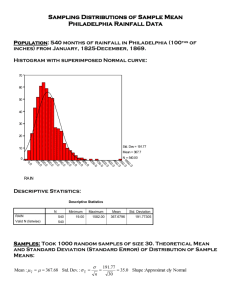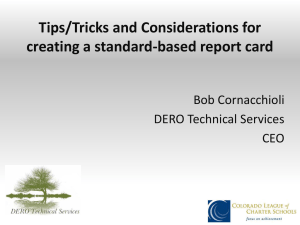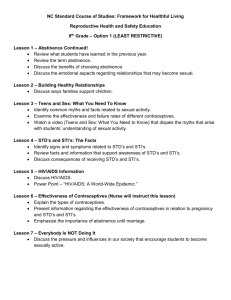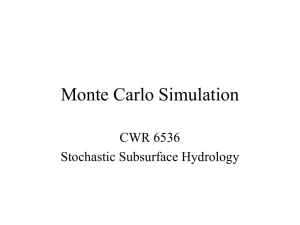Summary of results
advertisement
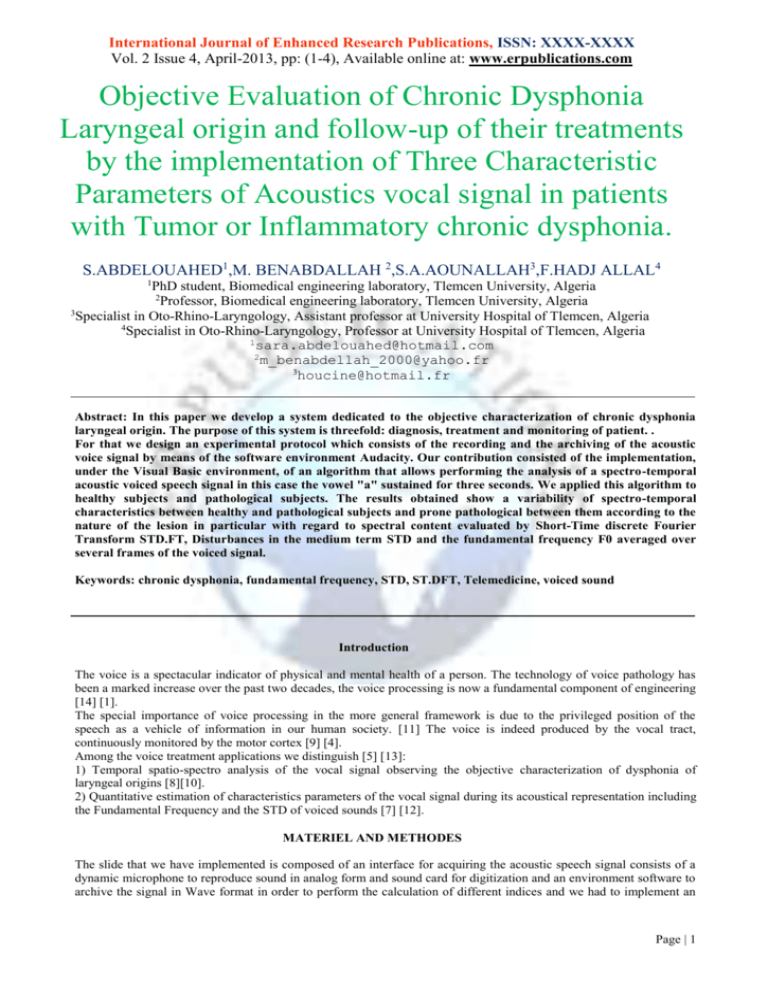
International Journal of Enhanced Research Publications, ISSN: XXXX-XXXX
Vol. 2 Issue 4, April-2013, pp: (1-4), Available online at: www.erpublications.com
Objective Evaluation of Chronic Dysphonia
Laryngeal origin and follow-up of their treatments
by the implementation of Three Characteristic
Parameters of Acoustics vocal signal in patients
with Tumor or Inflammatory chronic dysphonia.
S.ABDELOUAHED1,M. BENABDALLAH 2,S.A.AOUNALLAH3,F.HADJ ALLAL4
1
PhD student, Biomedical engineering laboratory, Tlemcen University, Algeria
2
Professor, Biomedical engineering laboratory, Tlemcen University, Algeria
3
Specialist in Oto-Rhino-Laryngology, Assistant professor at University Hospital of Tlemcen, Algeria
4
Specialist in Oto-Rhino-Laryngology, Professor at University Hospital of Tlemcen, Algeria
1sara.abdelouahed@hotmail.com
2m_benabdellah_2000@yahoo.fr
3
houcine@hotmail.fr
Abstract: In this paper we develop a system dedicated to the objective characterization of chronic dysphonia
laryngeal origin. The purpose of this system is threefold: diagnosis, treatment and monitoring of patient. .
For that we design an experimental protocol which consists of the recording and the archiving of the acoustic
voice signal by means of the software environment Audacity. Our contribution consisted of the implementation,
under the Visual Basic environment, of an algorithm that allows performing the analysis of a spectro-temporal
acoustic voiced speech signal in this case the vowel "a" sustained for three seconds. We applied this algorithm to
healthy subjects and pathological subjects. The results obtained show a variability of spectro-temporal
characteristics between healthy and pathological subjects and prone pathological between them according to the
nature of the lesion in particular with regard to spectral content evaluated by Short-Time discrete Fourier
Transform STD.FT, Disturbances in the medium term STD and the fundamental frequency F0 averaged over
several frames of the voiced signal.
Keywords: chronic dysphonia, fundamental frequency, STD, ST.DFT, Telemedicine, voiced sound
Introduction
The voice is a spectacular indicator of physical and mental health of a person. The technology of voice pathology has
been a marked increase over the past two decades, the voice processing is now a fundamental component of engineering
[14] [1].
The special importance of voice processing in the more general framework is due to the privileged position of the
speech as a vehicle of information in our human society. [11] The voice is indeed produced by the vocal tract,
continuously monitored by the motor cortex [9] [4].
Among the voice treatment applications we distinguish [5] [13]:
1) Temporal spatio-spectro analysis of the vocal signal observing the objective characterization of dysphonia of
laryngeal origins [8][10].
2) Quantitative estimation of characteristics parameters of the vocal signal during its acoustical representation including
the Fundamental Frequency and the STD of voiced sounds [7] [12].
MATERIEL AND METHODES
The slide that we have implemented is composed of an interface for acquiring the acoustic speech signal consists of a
dynamic microphone to reproduce sound in analog form and sound card for digitization and an environment software to
archive the signal in Wave format in order to perform the calculation of different indices and we had to implement an
Page | 1
International Journal of Enhanced Research Publications, ISSN: XXXX-XXXX
Vol. 2 Issue 4, April-2013, pp: (1-4), Available online at: www.erpublications.com
algorithm for converting Wave format to decimal format in Visual Basic environment. The experimental protocol
includes the following steps:
• Pronunciation of a voiced sound in this case 'a' sustained for three seconds.
• The division of the signal into 6 frames each 0.5 seconds
• The calculation of the three indices (spectral content, fundamental frequency and STD) averaged over six frames.
• The correlation between the indices themselves and the balance sheet and para-clinic of patients.
• The implementation of an interactive database of physiological and pathological acoustic voice signals for a clinical
and epidemiological study and better therapeutic management.
A. STD.FT algorithm
Temporal domain
Spectral domain
Input speech signal f (t)
Input F (f)
Sampling
𝑓̂ (𝑡) = 𝑓(𝑡). 𝜔𝑡,𝑇𝑠
Sampling
𝐹̂ (𝑓) = 𝐹(𝑓) ∗ 𝛺𝑓,𝐹𝑠
Limitation of the duration
𝑓̂𝑇0 (𝑡) = 𝑓̂ (𝑡). 𝜋 𝑇0 (𝑡)
Spectral repetition
𝐹̂𝑎 (𝑓) = 𝐹𝑒 ∑ 𝐹𝑎 (𝑓 − 𝑛. 𝐹𝑠 )
𝑛⋴𝕫
Periodization
𝑓̂𝑇0𝑝 (𝑡) = 𝑓̂ (𝑡). 𝜋 𝑇0 (𝑡) ∗ 𝜔𝑡,𝑇𝑠
Sampling frequency
𝐹̂𝑎𝑝 (𝑓) = 𝑓̂(𝑓) ∗ 𝐹𝑠 ∑ 𝐹𝑎 (𝑓 − 𝑛. 𝐹𝑠 ). 𝛺𝑓,𝐹𝑠
𝑛⋴𝑧
STD.FT
𝑁−1
𝑛
𝐹(𝑛) = ∑ 𝑓(𝑘) . 𝑒 −𝑗2𝜋𝑁𝑘
𝑘=0
n=0, 1, 2….. (N-1)
𝑁=
𝑇0
𝑇𝑠
= 𝑇0
It comprises the following steps [6][2]:
Sampling
The sampling in the time domain is to multiply the signal by a Dirac comb:
Where:
f̂(t) = f(t). ωt,Te
(1)
f̂(t) = f(t). ∑ δ(t − kTS )
(2)
k∈𝕫
+∞
F̂a (f) = Fe ∑ Fa (f − n. FS ) . ∑ F0 . δ(f − lF0 )
n⋴𝕫
l=−∞
The number of samples contained in the time sequence t is: N=T0 ⁄Ts Ts.
.
1 1
The number of samples contained in the spectral sequence is: N = ⁄ =
Ts T0
f̂(t) = ∑ f(k. Ts ). δ(t − kTs )
1
T
Ts 0=
T0 ⁄Ts
(3)
k∈𝕫
This amounts to a convolution frequency by another Dirac comb:
F̂(f) = F(f) ∗ Ωf,Fs
(4)
Page | 2
International Journal of Enhanced Research Publications, ISSN: XXXX-XXXX
Vol. 2 Issue 4, April-2013, pp: (1-4), Available online at: www.erpublications.com
Limiting the duration of the signal
Limiting the duration of the time sequence, generally dictated by the memory of the computers, obtained by multiplying
the latter by a rectangular door, height and length unit T0, sufficiently large for its spectrum can be treated as such is
approximately a Dirac impulse. This second operation provides us with a sequence containing truncated N samples:
𝑓̂𝑇0 (𝑡) = ∑𝑁−1
𝑘=0 𝑓(𝑘. 𝑇𝑠 ). 𝛿(𝑡 − 𝑘𝑇𝑠 )
(5)
On the spectral plane is approximated the FT of the window truncation by a Dirac truncation, which gives:
̂ (𝑡)}
̂ 𝑎 (𝑓) = 𝛿𝑓 ∗ ℱ{𝑓
𝐹
𝑡0
= ℱ{𝑓̂𝑡0 (𝑡)}
= 𝐹̂𝑎 (𝑓)
𝐹̂𝑎 (𝑓) = 𝐹𝑠 ∑𝑛⋴𝕫 𝐹𝑎 (𝑓 − 𝑛. 𝐹𝑠 )
(6)
Periodization of the signal
Periodization of:
𝑁−1
𝑓̂𝑇0 (𝑡) = ∑ 𝑓(𝑘. 𝑇𝑠 )𝛿(𝑡 − 𝑘𝑇𝑠 )
𝑘=0
Is obtained by convolution with a Dirac comb of period T0 which gives:
𝑁−1
+∞
𝑓̂𝑇0𝑝 (𝑡) = [∑ 𝑓(𝑘. 𝑇𝑠 ). 𝛿(𝑡 − 𝑘𝑇𝑠 )] ∗ [ ∑ 𝑇0 . 𝛿(𝑡 − 𝑙𝑇0 )] (7)
𝑘=0
𝑙=−∞
𝑁 = 𝑇0 ⁄𝑇𝑠
The number of samples contained in each of the time periods is equal to the number of samples contained in each of
spectral periods.
ST.DFT definition
The discrete Fourier transform of the infinite sequence of samples is:
ℱ{f̂T0 (t)} = ℱ{∑k∈𝕫 f(k. Ts ). δ(t − kTs )}
ℱ{̂fT0 (t)} = ∑k∈𝕫 f(k. Ts ). e−j2πfkTs
(8)
Where the spectrum obtained after periodization is discreet and its samples are separated by the interval F0, the
frequency takes the values:
N−1
ℱ{𝑓̂𝑇0 (𝑡)} = ∑ f(k) . e−j2πfkTs
(9)
k=0
𝑓 = 𝑓0 . 𝑛 =
𝑛
𝑇0
With n=0, 1, 2…. (N-1). It follows:
𝑛
−𝑗2𝜋𝑓𝑘𝑇𝑠
ℱ{𝑓̂𝑇0 (𝑡)} = F (𝑇 ) = ∑𝑁−1
𝑘=0 𝑓(𝑘) . 𝑒
0
n=0, 1, 2…. (N-1).
𝑛
−𝑗2𝜋𝑛𝑘⁄𝑁
F (𝑇 ) = ∑𝑁−1
𝑘=0 𝑓(𝑘) . 𝑒
0
(10)
It usually arises to simplify calculations T0 = 1, where the normal forms of the discrete Fourier transform:
𝑛
−𝑗2𝜋 𝑘
𝑁
F(n) = ∑𝑁−1
𝑘=0 𝑓(𝑘) . 𝑒
(11)
𝑁 = 𝑇0 ⁄𝑇𝑠 = 𝑇0
Page | 3
International Journal of Enhanced Research Publications, ISSN: XXXX-XXXX
Vol. 2 Issue 4, April-2013, pp: (1-4), Available online at: www.erpublications.com
B.
Global algorithm of the application
Recording the vocal signal via Audacity
software
Data conversion from the WAVE format to
hexadecimal one
The signal windowing
The signal layout
The Calculation and the layout of the ST.DFT
RD
Calculation of STD
Calculates the average fundamental frequency
The fundamental frequency is established by gliding average method [3] [12 ] and STD are given by the following
equations:
𝑁
1
(𝑖)
𝐹𝑠 = ∑ 𝐹𝑠
𝑁
𝑖=1
1
STD=√ ∑𝑁
(𝐹
𝑁 𝑖=1 𝑠
(𝑖)
− 𝐹𝑠 )2
Summary of results
Table 1: The STD and the average fundamental frequency of healthy subjects of corpus
Healthy subjects
Fundamental
frequencies Fs (HZ)
st
1 selection
2nd selection
3rd selection
4th selection
5th selection
6th selection
The average
fundamental
frequencies (HZ)
STD (sec)
1st
subject
2nd
subject
3rd
subject
4th
subject
5th
subject
6th
subject
7th
subject
8th
subject
Male sexe
9th
subject
10th
subject
Female sexe
227.05
184.81
184.81
227.05
195.12
184.8
200.6
200.65
211.2
184.8
184.8
211 .4
195.37
198.03
190.09
184.8
184.8
216.49
184.81
211.21
196.68
184.81
211.21
179.53
184.81
211.21
184.8
192.72
216.49
184.81
200.65
221.77
200.65
184.81
201.53
205.93
179.53
221.77
205.93
184.81
205.93
200.65
184.81
205.93
227.05
211.21
195.37
195.37
203.29
211.21
190.09
195.37
216.49
179.53
195.37
198.01
200.65
211.2
184.8
184.8
184.81
195.37
193.59
190.09
184.8
184.8
216.49
184.81
211.21
195.36
13.94
13.58
13.29
13.2
12.93
13.49
13.17
13.17
12.44
13.28
Table 2: The STD and the average fundamental frequency of sick subjects of corpus
sick subjects
Fundamental
frequencies Fs (HZ)
1stselection
2nd selection
3rd selection
4th selection
5th selection
6th selection
The average
fundamental
frequencies (HZ)
STD (sec)
1st
subject
2nd
subject
3rd
subject
73.92
73.92
52.8
73.92
63.36
73.92
68.64
58.08
47.52
47.5
42.24
42.24
47.52
47.51
68.64
47.52
47.52
68.64
68.64
73.92
62.48
4.97
5.28
4.5
4th
subject
7th
subject
8th
subject
9th
subject
10th
subject
5th
subject
6th
subject
47.52
52.8
52.8
47.58
58.08
58.08
52.81
47.52
63.36
47.52
58.08
63.36
68.64
58.08
50.52
67.36
50.52
58.08
68.64
47.52
57.10
105.6
147.85
126.73
142.57
105.6
110.88
123.20
121.44
105.6
110.88
100.32
137.29
137.29
118.8
105.6
137.29
126.73
110.88
121.44
105.6
117.92
174.25
163.69
142.57
174.81
163.69
142.57
160.17
4.29
4.31
4.78
8.97
9.97
8.13
10.31
Pathologie tumorale
Pathologie inflammatoire
Page | 4
International Journal of Enhanced Research Publications, ISSN: XXXX-XXXX
Vol. 2 Issue 4, April-2013, pp: (1-4), Available online at: www.erpublications.com
Discussion of results
In healthy subjects, the fundamental frequency was situated at around 200 Hz. corresponding to the physiological
frequency of vowel “a”. STD extend to 13 Hz.
In patients with the cancer of vocal cords, the fundamental frequency was significantly reduced by around to 60 Hz,
while the STD was greatly decreased to 4Hz.
In patients with inflammatory disease (chronic laryngitis), the fundamental frequency was reduced to 120Hz, and STD
was decreased slightly to 8 Hz.
In the inflammatory polyp of vocal cords, fundamental frequency slightly decreased to 160 Hz, while STD was slightly
decreased to 10 Hz. The spectral range was significantly diminished in cancer patients due to the total absence of
vibration of vocal cords. This limitation of frequency range was also present but truncated in the case of chronic
inflammatory disease of the larynx.
Conclusion
Characterization and objective assessment of chronic dysphonia were studied using three parameters. The
fundamental frequency was around 120 Hz and the STD was around 9Hz in cases of inflammatory disease, while the
frequency was low at around 60 Hz and the STD increased to 4 Hz in larynx cancer, where the STD was three times
smaller than healthy subjects.
The clinical and para-clinical examinations, notably the pathological diagnosis, were in perfect agreement with the
evolution of their indices. Clinical validation of the results is still subject to much larger samples supported by a
rigorous statistical support.
References
[1] A.Drygajlo, « Traitement de la parole »-Partie 1-, école Polytechniques Fédérale de Lausane EPFL, 1998.
[2] L.Benlaldj, « Etude de la méthode PLP (Perceptual linear prediction) en reconnaissance automatique de la parole », Thèse de
magister en électronique, spécialité : Signaux et Systèmes, promotion 1999/2000.
[3] LAKHDAR Mohammed Hicham, HASSAM Ahmed, « classification des sons de la parole par la technique PLP », Mémoire de
fin d’étude pour l’obtention du diplôme d’ingénieur d’état en contrôle, Université ABOU BEKER BELKIAD TELEMCEN ,2001.
[4] Calliope, la parole et son traitement automatique, Ed. Masson, 1989.
[5] T. Dutoit, « Introduction au Traitement Automatique de la Parole », Notes de cours, Faculté Polytechnique de Mons, 2000.
[6] Dr. ANDRZEJ DRYGAJLO, « TRAITEMENT DE LA PAROLE », “Interactive Multimodal Information Management (IM)2” ,
Laboratory of IDIAP (LIDIAP) Institute of Electrical
Engineering (IEL) ,Swiss Federal Institute of Technology
[7] Dr Camille Finck, chapitre sur « L’évaluation fonctionnelle des dysphonie d’origine laryngé », Service d'Oto-rhino-laryngologie,
CHU sart Tilman, Université de Liège, Liège, Belgium.
[8]
GHIO, A.; GIOVANNI, A.; TESTON, B.; RÉVIS, J.; YU, P.; OUAKNINE, M.; ROBERT, D.; LEGOU, T. Bilan et
perspectives de quinze ans d’évaluation vocale par méthodes instrumentales et perceptives. Actes, Journées d'Etude sur la Parole
(JEP) (27 : 2008 juin 9-13 : Avignon, FRANCE). . Avignon: LIA. 2008
[9] GHIO, A.; POUCHOULIN, G.; GIOVANNI, A.; FREDOUILLE, C.; TESTON, B.; RÉVIS, J.; BONASTRE, J.-F.; ROBERT, D.;
YU, P.; OUAKNINE, M.; GUARELLA, M.-D.; SPEZZA, C.; LEGOU, T.; MARCHAL, A. Approches complémentaires pour
l'évaluation des dysphonies : bilan méthodologique et perspectives. Travaux Interdisciplinaires du Laboratoire Parole et Langage
d'Aix-en-Provence (TIPA), vol. 26. 2008, p. 33-74.
[10] YU P., GARREL R., NICOLLAS R., OUAKNINE M., GIOVANNI A., (2007), "Objective voice analysis in dysphonic patients.
New data including non linear measurements", Folia Phoniatrica et Logopaedica, 59:20-30. Lausanne (EPFL).
[11] Giovanni A., Yu P., Révis J., Guarella MD., Teston B., Ouaknine M. (2006). "Analyse objective des dysphonies avec
l'appareillage EVA. Etat des lieux.", Revue Oto-Rhino-Laryngologie Française, 90, p3 183-192
[12] TESTON, B. L'évaluation instrumentale des dysphonies. Etat actuel et perspectives. In Giovanni A. (ed.) Le bilan d'une
dysphonie. ISBN 2-914513-62-3. Marseille: Solal. 2004, p. 105-169.
[13] VIALLET, F.; TESTON, B. Objective evaluation of dysphonia: acoustic and aerodynamic methods. Proceedings of European
Laryngological Society: Around dysphasia, dysarthria, dysphonia (2003: Toulouse, FRANCE). 2003, p. 53-55.
[14] Emmanuelle Guibert, « Caractéristiques physiques et auditives d’un signal sonore ».
[15]
GUY ALMOUZNI, « traitement de la parole »,2011.
Page | 5

